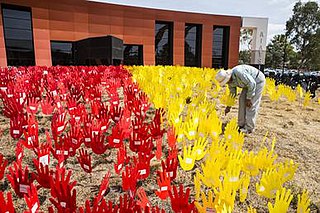This page is based on this
Wikipedia article Text is available under the
CC BY-SA 4.0 license; additional terms may apply.
Images, videos and audio are available under their respective licenses.

The Kabalbara also rendered Gabalbura and Gabulbarra, is an Australian aboriginal tribe of northern Queensland. No linguistic information has been recorded.
The Tharrkari, also referred to as the Targari, are an indigenous Australian tribe of Western Australia.
The Thalandji are an indigenous Australian people in the Pilbara region of Western Australia.
The Ninanu were an indigenous Australian people of the Gascoyne region of Western Australia.
The Djiwarli are an indigenous Australian people of Western Australia.
The Tenma or Thiin were an indigenous Australian people of Western Australia.
The Buruna are an indigenous Australian people of the Mid West region of Western Australia.
The Binigura were an indigenous Australian people of the Pilbara region of Western Australia.
The Inawongga were an indigenous Australian people of the Pilbara region of Western Australia.
The Malngin were an indigenous Australian people of Western Australia. The Malngin language was a dialect of Gurindj.
The Kokobujundji were an indigenous Australian people of the state of Queensland.
The Gugu Rarmul were an indigenous Australian people of the state of Queensland, one of several whose speech was called Gugu Yawa.
The Laia were an indigenous Australian people of the state of Queensland.
The Lanima were an indigenous people of the state of Queensland.
The Rakkaia were an indigenous Australian tribe of the state of Queensland.
The Yangaa were an indigenous Australian people of the state of Queensland. They may be the same as the Nyangga. They are not to be confused with the Yangga.
The Jokula (Yukulta) were an indigenous Australian people of the state of Queensland.
The Kunja (Gunya) were an indigenous Australian people of the state of Queensland.
The Kongabula were an indigenous Australian people of the state of Queensland.
The Kukatj were an indigenous Australian people of the state of Queensland. They are to be distinguished from the Kukatja, either the Northern Territory Loritja or the Western Australian Gugadja.





